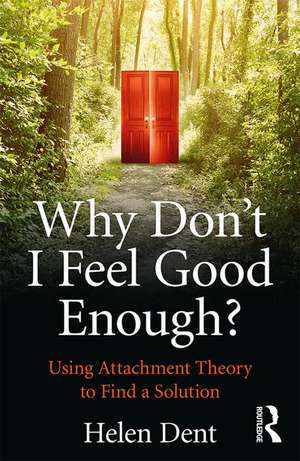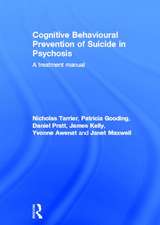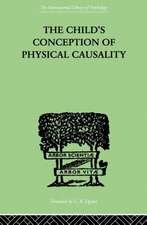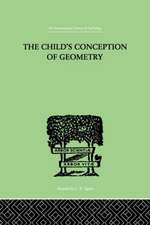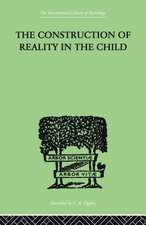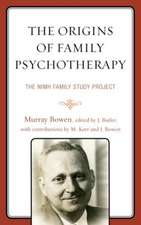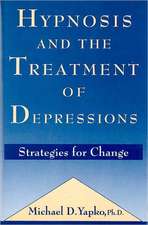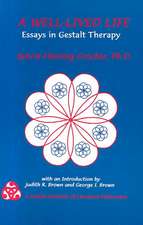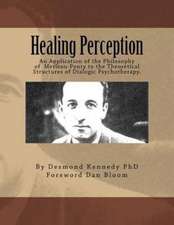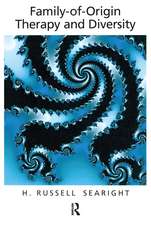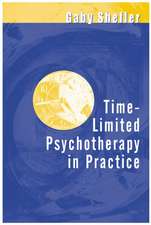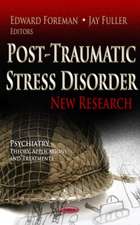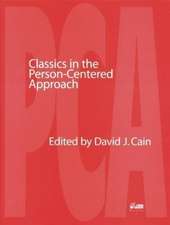Why Don't I Feel Good Enough?: Using Attachment Theory to Find a Solution
Autor Helen Denten Limba Engleză Paperback – 19 sep 2018
Bringing a wealth of therapeutic experience and the latest scientific research, Helen Dent introduces the benefits that understanding attachment theory can bring to all areas of life. You will find this particularly helpful if you struggle with everyday relationships and have difficulties managing your emotions. Using practical guidance, real-life examples and questionnaires to help you locate your own 'attachment style', she provides the tools and guidance to help you move on and develop secure, positive attachments.
Why Don’t I Feel Good Enough?will be an important guide and resource for psychotherapists, counsellors, clinical psychologists and their clients. It provides a good introduction to attachment theory for professionals in training.
Preț: 162.36 lei
Preț vechi: 170.91 lei
-5% Nou
Puncte Express: 244
Preț estimativ în valută:
31.08€ • 33.77$ • 26.12£
31.08€ • 33.77$ • 26.12£
Carte disponibilă
Livrare economică 31 martie-14 aprilie
Livrare express 14-20 martie pentru 27.88 lei
Preluare comenzi: 021 569.72.76
Specificații
ISBN-13: 9781138943513
ISBN-10: 1138943517
Pagini: 264
Ilustrații: 16 Tables, black and white; 22 Line drawings, black and white; 22 Illustrations, black and white
Dimensiuni: 129 x 198 x 22 mm
Greutate: 0.49 kg
Ediția:1
Editura: Taylor & Francis
Colecția Routledge
Locul publicării:Oxford, United Kingdom
ISBN-10: 1138943517
Pagini: 264
Ilustrații: 16 Tables, black and white; 22 Line drawings, black and white; 22 Illustrations, black and white
Dimensiuni: 129 x 198 x 22 mm
Greutate: 0.49 kg
Ediția:1
Editura: Taylor & Francis
Colecția Routledge
Locul publicării:Oxford, United Kingdom
Public țintă
Further/Vocational Education, General, Postgraduate, Professional, and Professional Practice & DevelopmentCuprins
Contents
Part One: Why Don’t I Feel Good?
Further Reading
References
Index
List of Figures
Figure 2.1 Circles of context
Figure 2.2 Johari Window
Figure 2.3 Johari Window after Self-Exploration
Figure 3.1 The Attachment Cycle – Development of Trust & Secure Attachment
Figure 3.1 Development of Emotional Understanding & Regulation
Figure 3.1 Development of Shame
Figure 3.1 Relationship Repair
Figure 4.1 Secure Attachment Style
Figure 4.1 Pyramid of Personal Fulfilment
Figure 4.1 Anxious Attachment Style
Figure 4.1 Avoidant Attachment Style
Figure 4.1 Disorganised Attachment Style
List of Tables
Table 4.1 Labels Given to Infant and Adult Attachment Styles
Table 4.2 Bowlby’s Original Classification of Attachment Styles
Table 5.1 Adult Attachment Behaviours
Table 14.1 Universal Emotional States
Table 14.1 Forms of Dissociation
Table 14.1 Symptoms of Post-Traumatic Stress
List of Exercises
Exercise 6.1 Assessment Flowchart
Exercise 6.2 Genogram Symbols
Exercise 6.1 Eva’s Genogram
Exercise 6.1 Zac’s Genogram
Exercise 7.1 Attachment Style Vignettes
Exercise 7.1 My Attachment Style Questionnaire
Exercise 7.1 My Attachment Style Questionnaire – Eva
Exercise 7.1 My Attachment Style Questionnaire – Dan
Exercise 7.1 My Attachment Style Questionnaire – Jas
Exercise 7.1 My Attachment Style Questionnaire – Zac
Exercise 8.1 Five P’s Formulation
Exercise 8.1 Nine Steps Formulation
Exercise 8.1 Eva’s Formulation Map
Exercise 8.1 Dan’s Five P’s Formulation
Exercise 8.1 Jas’s Formulation Picture
Exercise 8.1 Zac’s Formulation Story
Exercise 14.1 Jas’s Record of Emotions
Exercise 15.1 Self-Imposed Barriers to Change
Exercise 15.2 ROSE acronym for managing intense emotion
Exercise 16.1 Subjective Units of Distress for Measuring Progress
a
Part One: Why Don’t I Feel Good?
- How Can I Help You?
- Feeling Good
- Surviving and Thriving - Attachment Theory
- How Attachment Styles are Formed
- Attachment Styles in Adulthood
Part Two: Taking Action - Mapping My Inner Life
- Family History and the Genogram
- Working Out My Attachment Style
- Putting It All Together – Formulating My Psychological Map
Part Three: Becoming Aware of the Hidden Forces in My Relationships
- Romantic Partners
- Family and Friends
- Colleagues
- Other Relationships
Part Four: Feeling Good - Learning to Take Control of My Life
- Taking Care of Myself
- Managing My Emotions
- Managing My Behaviours
- Where Can I Get Further Help?
Part Five: Additional Information
- Strengths and Limitations of Research Evidence
Further Reading
References
Index
List of Figures
Figure 2.1 Circles of context
Figure 2.2 Johari Window
Figure 2.3 Johari Window after Self-Exploration
Figure 3.1 The Attachment Cycle – Development of Trust & Secure Attachment
Figure 3.1 Development of Emotional Understanding & Regulation
Figure 3.1 Development of Shame
Figure 3.1 Relationship Repair
Figure 4.1 Secure Attachment Style
Figure 4.1 Pyramid of Personal Fulfilment
Figure 4.1 Anxious Attachment Style
Figure 4.1 Avoidant Attachment Style
Figure 4.1 Disorganised Attachment Style
List of Tables
Table 4.1 Labels Given to Infant and Adult Attachment Styles
Table 4.2 Bowlby’s Original Classification of Attachment Styles
Table 5.1 Adult Attachment Behaviours
Table 14.1 Universal Emotional States
Table 14.1 Forms of Dissociation
Table 14.1 Symptoms of Post-Traumatic Stress
List of Exercises
Exercise 6.1 Assessment Flowchart
Exercise 6.2 Genogram Symbols
Exercise 6.1 Eva’s Genogram
Exercise 6.1 Zac’s Genogram
Exercise 7.1 Attachment Style Vignettes
Exercise 7.1 My Attachment Style Questionnaire
Exercise 7.1 My Attachment Style Questionnaire – Eva
Exercise 7.1 My Attachment Style Questionnaire – Dan
Exercise 7.1 My Attachment Style Questionnaire – Jas
Exercise 7.1 My Attachment Style Questionnaire – Zac
Exercise 8.1 Five P’s Formulation
Exercise 8.1 Nine Steps Formulation
Exercise 8.1 Eva’s Formulation Map
Exercise 8.1 Dan’s Five P’s Formulation
Exercise 8.1 Jas’s Formulation Picture
Exercise 8.1 Zac’s Formulation Story
Exercise 14.1 Jas’s Record of Emotions
Exercise 15.1 Self-Imposed Barriers to Change
Exercise 15.2 ROSE acronym for managing intense emotion
Exercise 16.1 Subjective Units of Distress for Measuring Progress
a
Notă biografică
Helen Dent is Emeritus Professor of Clinical and Forensic Psychology at Staffordshire University.
Descriere
Why Don’t I Feel Good Enough? Using Attachment Theory to Find a Solution offers a guide to how early emotional bonds affect our adult relationships and how psychological theory can help us to find the origin and solution to a number of life’s problems.
